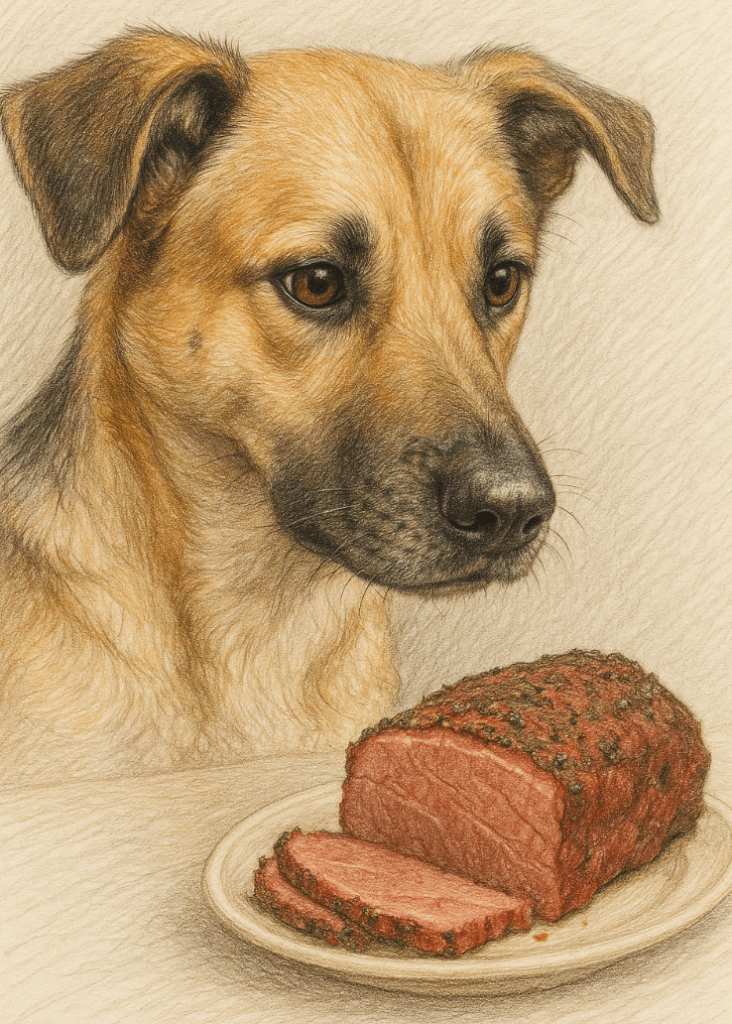Can Dogs Eat Pastrami?
When it comes to sharing human food with our furry friends, it’s essential to tread carefully. Many dog owners wonder whether pastrami—a popular deli meat—is safe for their canine companions. While dogs can eat some human foods in moderation, others may pose serious health risks. Pastrami, known for its rich flavor and high sodium content, falls into a gray area. Understanding the potential benefits and dangers of feeding pastrami to your dog is crucial to ensuring their well-being. In this blog post, we’ll explore everything you need to know about dogs and pastrami, from nutritional considerations to safer alternatives.
Potential Risks of Feeding Pastrami to Dogs
While pastrami might seem like a tasty treat for your dog, it comes with several risks that every pet owner should be aware of. These hazards can range from mild discomfort to severe health issues.
High Sodium Content:
Pastrami is notoriously salty, which can lead to dehydration, increased thirst, and even sodium ion poisoning in dogs.Spices and Seasonings:
Many pastrami recipes include garlic, onion powder, or other seasonings that are toxic to dogs and can damage their red blood cells.Fat Content:
The high fat content in pastrami can upset your dog’s stomach and potentially lead to pancreatitis, a painful and dangerous condition.Nitrates and Preservatives:
Processed meats like pastrami often contain nitrates and preservatives, which may increase the risk of cancer or other long-term health issues.Choking Hazards:
Large chunks of pastrami can pose a choking risk, especially for smaller breeds or dogs prone to gulping their food.
These risks highlight why caution is essential when considering giving pastrami to your dog. Always prioritize their safety over curiosity or convenience.
Benefits of Pastrami (If Any) for Dogs
While pastrami isn’t an ideal food for dogs, there are a few minor benefits if given in extremely small amounts under specific circumstances. However, these advantages are outweighed by the risks.
Protein Content:
Pastrami is high in protein, which is essential for muscle development and overall health in dogs.Energy Boost:
The calories in pastrami can provide a quick energy boost, though this is only beneficial for highly active dogs.Palatability:
Most dogs enjoy the taste of meat, so pastrami might entice picky eaters to consume their regular food when mixed sparingly.Iron Source:
Pastrami contains iron, which supports healthy blood circulation and oxygen transport in the body.Temporary Treat Option:
In rare cases, a tiny piece of plain, unseasoned pastrami might serve as an occasional reward during training sessions.
While these benefits exist, they must be weighed against the significant health risks before offering pastrami to your dog.
Check this guide 👉Can Dogs Eat Ricotta Cheese? Best 7 Expert Tips!
Check this guide 👉Can Dogs Eat Taro? Best 7 Expert Tips!
Check this guide 👉Can Dogs Eat Gelatin? Best 7 Expert Tips!

Safe Alternatives to Pastrami | Risks of Unsafe Human Foods |
|---|---|
Plain, cooked chicken breast | Garlic and onion-containing foods |
Low-sodium turkey slices | Processed meats with nitrates |
Fresh vegetables like carrots or peas | High-fat foods like bacon or sausage |
Dog-safe treats with natural ingredients | Sugary snacks or desserts |
Bone broth (unsalted and strained) | Alcohol or caffeine-based products |
How to Safely Introduce Pastrami to Your Dog (If Necessary)
If you decide to give your dog pastrami, it’s essential to take precautions to minimize risks. Follow these guidelines to ensure a safe experience.
Choose Plain Pastrami:
Opt for unseasoned, low-sodium pastrami without added spices, garlic, or onion powder.Offer Tiny Portions:
Give only a very small piece—no larger than a fingernail—to avoid overwhelming their system.Monitor for Reactions:
Watch for signs of digestive upset, such as vomiting, diarrhea, or excessive thirst, after feeding.Avoid Regular Feeding:
Pastrami should never become a staple in your dog’s diet; reserve it for rare occasions, if at all.Consult Your Veterinarian:
Before introducing any new food, seek advice from your vet to ensure it aligns with your dog’s specific dietary needs.
By following these steps, you can mitigate risks while allowing your dog to enjoy the occasional indulgence safely.
Signs Your Dog May Be Struggling After Eating Pastrami
Even with precautions, complications can arise if your dog consumes pastrami improperly. Watch for these warning signs to act quickly if something goes wrong.
Excessive Thirst or Urination:
These symptoms may indicate sodium poisoning, requiring immediate veterinary attention.Vomiting or Diarrhea:
Digestive issues often occur after consuming fatty or heavily seasoned foods like pastrami.Lethargy or Weakness:
A sudden lack of energy could suggest toxicity or an adverse reaction to the food.Difficulty Breathing:
Swelling of the throat or difficulty breathing may signal an allergic reaction or choking hazard.Loss of Appetite:
Refusal to eat or drink could indicate nausea or gastrointestinal distress caused by the pastrami.
Recognizing these signs early allows you to seek veterinary care promptly, preventing further complications.
Common Mistakes to Avoid When Feeding Human Food to Dogs
Feeding human food to dogs requires careful consideration to avoid mistakes that could endanger their health. Here are some pitfalls to watch out for.
Assuming All Meats Are Safe:
Processed meats like pastrami, bacon, or ham are unhealthy for dogs due to their high salt and fat content.Ignoring Ingredient Labels:
Many human foods contain hidden toxins like garlic, onion powder, or artificial sweeteners that are harmful to dogs.Overfeeding Treats:
Even safe human foods should be given in moderation to avoid upsetting your dog’s balanced diet.Leaving Food Unattended:
Dogs are opportunistic eaters and may snatch unsafe foods if left within reach.Skipping Veterinary Advice:
Always consult your vet before introducing new foods to ensure they align with your dog’s unique needs.
Avoiding these mistakes ensures a safer and healthier experience for your dog.
Alternatives That Mimic the Flavor of Pastrami
If you’re looking to satisfy your dog’s craving for savory flavors without the risks of pastrami, there are plenty of alternatives that mimic its taste safely.
Plain Cooked Turkey:
Low-sodium turkey slices provide a similar texture and flavor without the harmful additives found in pastrami.Homemade Dog Treats:
Prepare homemade treats using lean meats and dog-safe ingredients to create a customized snack.Low-Sodium Chicken Jerky:
Commercially available jerky made specifically for dogs offers a chewy, flavorful option without excess salt.Steamed or Boiled Beef:
Plain, unseasoned beef is a protein-rich alternative that dogs find irresistible.Vegetable-Based Snacks:
Carrots, green beans, or sweet potatoes can complement meaty flavors while adding nutritional value.
These alternatives allow you to cater to your dog’s taste buds while keeping them safe.
Understanding Your Dog’s Natural Instincts Around Food
Dogs are naturally drawn to meaty, savory flavors like pastrami because of their evolutionary history as scavengers and hunters. Understanding their instincts helps explain their fascination.
Scavenging Behavior:
Wild ancestors relied on scavenging for food, making dogs naturally curious about human meals.
Craving Protein:
As carnivores, dogs instinctively seek out protein-rich foods to meet their nutritional needs.Taste Preferences:
Dogs have fewer taste buds than humans but are highly attracted to umami flavors found in meats like pastrami.Food Motivation:
Many dogs associate food with rewards, making them eager to try anything their owners are eating.Territorial Marking:
Protecting or hoarding food is rooted in survival instincts, which can influence their eagerness to eat unfamiliar items.
By recognizing these behaviors, you can better address your dog’s needs in a safe and controlled manner.
Frequently Asked Questions About Dogs and Pastrami
Is pastrami safe for dogs in small amounts?
While a tiny piece of plain pastrami may not harm most dogs, it’s best avoided due to its high sodium and fat content.
What should I do if my dog eats a large amount of pastrami?
Contact your veterinarian immediately, especially if the pastrami contains garlic, onions, or other harmful ingredients.
Can puppies eat pastrami?
Puppies have sensitive digestive systems and should avoid pastrami entirely to prevent health issues.
Are there healthier deli meats for dogs?
Lean, unseasoned meats like turkey or chicken are safer options but should still be given sparingly.
What are the symptoms of sodium poisoning in dogs?
Symptoms include excessive thirst, vomiting, diarrhea, tremors, and seizures—seek emergency care if suspected.
Prioritizing Your Dog’s Health When It Comes to Pastrami
Feeding pastrami to your dog can be tempting, especially if they’re eyeing your sandwich with pleading eyes. However, the risks outweigh the minimal benefits, making it a food best avoided. By understanding the potential dangers, choosing safer alternatives, and consulting your veterinarian, you can ensure your dog stays healthy and happy. Remember, your furry friend relies on you to make the best dietary choices for them—so always prioritize their well-being above all else.
Canned Pumpkin for Cat Diarrhea: Best 7 Expert Tips! Natural remedy to firm stools, soothe upset bellies, and support gut health safely.
Can a Cat Give You Scabies? Best 7 Expert Tips! Discover the truth about feline mites, human skin risks, and how to protect yourself—without panic.
Cat Flea vs Human Flea: Best 7 Expert Tips! Discover the truth about bites, species, and how to eliminate infestations for good.
Weird Cat Behaviors: Best 7 Expert Tips! Discover why cats do strange things—and how to understand, not punish, their instincts for a happier home.





